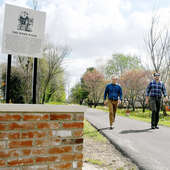Financial security for you and those you love through planned giving

As you plan for today and tomorrow, careful consideration of your financial and estate plan is important to ensure you have enough to provide for you and your family’s wellbeing. It is also likely that, throughout your life, you have come to care deeply for the good work of certain charitable organizations, such as a church or an agency specializing in education, culture, health care or social service.

What if you knew that thoughtfully incorporating philanthropy into your financial and estate plans can be done without negatively impacting — and actually enhancing — your financial future? This is true, and the ways to do so can range from being simple to quite complex. Making a well-planned charitable gift is truly one of life’s most satisfying experiences.
Below are a just a few situations I've encountered while working in charitable gift planning for the past 26 years. Each story provides an example of a simple way these individuals have enjoyed the satisfaction of knowing they have cared for themselves, their loved ones and the causes they hold dear.
Appreciated Assets: Doubling the Benefit
Many individuals hold non-cash assets such as stock and real estate that have increased significantly in value over the years. Although these highly appreciated assets may be good to hold onto, selling them can result in a significant capital gains tax.
If you are interested in making a charitable gift, however, donating these long-term appreciated assets (non-cash assets that you have held more than a year and have grown in value) may offer an opportunity to make a larger impact at the charity than you ever thought possible.
For example, when local entrepreneur Jim Riley and his wife Michaele wanted to support the Safe House of Southeast Missouri, their financial advisor helped them identify appreciated stock to donate rather than cash. By doing so, they not only received an income tax deduction for the current value of the stock, but they also eliminated the capital gains tax that otherwise would have been due if they had sold the stock.
Any size gift —small or large — can easily be made by donating appreciated assets and receiving double the tax benefits.
Individual Retirement Accounts: A Gift for Today
Several years ago, a husband and wife were both approaching the age of 70 ½ years old and their financial advisor explained they needed to begin taking annual distributions from their Individual Retirement Accounts (IRAs).
They did not need the funds to maintain their lifestyle and were quite concerned that because the Required Minimum Distributions (RMDs) would count as taxable income, these funds would negatively impact their tax situation.
Knowing this couple had regularly given to charity, specifically supporting health care and education, their financial advisor recommended these funds be transferred directly to the charities the couple had long supported.
Through Qualified Charitable Distributions (QCDs) sometimes referred to as IRA charitable rollovers, the donated funds did not count as income to the couple. The transfers fully met the couple’s RMDs, and the charities benefited tremendously.
Since this time, the age to begin RMDs from your IRA has risen to 72 years old, but direct donations from your IRA through a QCD are still allowed starting at 70½ years old.
Gifts both small and large (up to a total of $100,000 per year) are given in this way. The income is never taxed, so this is quite a smart way to give.
Donor Advised Funds: Bunching Gifts for Maximum Benefit
A Donor Advised Fund (DAF) provides an opportunity for donors to benefit from an income tax deduction for the full amount donated in the year the gift is made, and then offers the opportunity to make smaller grants from the DAF to charities on their own timetable.
For example, if a donor gave $25,000 to the DAF in 2019, and then made a $5,000 grant to a church in 2021 and a $2,500 gift to another charity in 2022, that person would receive a tax deduction for $25,000 given in 2019, but not in 2021 and 2022.
Several years ago, a local family chose to establish a DAF with the Cape Area Community Foundation to help streamline their charitable giving while supporting their church and other nonprofit organizations in Southeast Missouri. In recent years, donors have also found a new way to utilize a DAF to help maximize their charitable giving tax benefits.
To explain, far fewer taxpayers are itemizing their deductions each year because of the higher standard deductions put in place several years ago. You may be one of those who now finds it more beneficial to take the standard deduction and, as a result, are unable to take advantage of the charitable tax deductions available from your donations.
Through a DAF, you might find it beneficial to “bunch” charitable gifts by giving larger amounts every other year, or less frequently, instead of smaller gifts every year. By planning your philanthropy in this way, the initial gift to a DAF can be large enough for you to itemize your deductions that year.
In subsequent years as you make grants, you can take the standard deduction while your charities receive the much-needed annual support they rely on. The result is a win-win for all involved.
Charitable Gift Annuities: Giving and Receiving
With all the ups and downs in the financial markets, you might want to look at a gift arrangement called a Charitable Gift Annuity (CGA) which is offered by many larger charities. A CGA provides a secure fixed income for life, offers a relatively high rate of return, results in a partial income tax deduction in the year of the gift and ensures a generous future gift to your chosen charity.
For example, retired professor Dr. Linda Burns, who was 70 years old at the time of her gift, established a CGA to support educational opportunities for Southeast Missouri State University students at KRCU Public Radio.
The donor and the charity signed a simple agreement by which the charity committed to paying 5.3% per year to her for the rest of her life — a much higher rate of return than rates offered through savings accounts or Certificates of Deposit (CDs) at the time. The payout rate in this example and for CGAs offered by all charities are recommended by the American Council on Gift Annuities based on the donor's age. Furthermore, she received an immediate tax deduction for a portion of her gift and the annual payments she has received each year since the CGA was established have been partially tax-free.
While she benefits during her life, she can also rest assured that KRCU and the Southeast Missouri State University students who gain experience in broadcasting at the radio station will benefit through her legacy gift in the future.
Life Insurance: An Unexpected Opportunity
One of the less commonly used, but more flexible gift planning tools for donors of all ages is life insurance. Parker Butler, who graduated in 2016 from Southeast Missouri State University, was offered term life insurance from his employer and he chose to make the Southeast Missouri University Foundation the beneficiary because of the impact the university had on his life. Butler can change his mind at any time, but he knows he will be giving back in a significant way if something were to happen to him.
On the other end of the spectrum, an older alumnus of Southeast Missouri State University lost his wife quite unexpectedly. His attorney suggested converting an existing paid-up life insurance policy to provide for scholarships at both his alma mater and the college his wife graduated from, since that policy no longer served the original purpose of providing for his family. In this case, his gift was accomplished by simply changing the beneficiary designation and retaining the ability to change the beneficiary in the future.
Another option would have been to transfer ownership of the policy to charity resulting in a current tax benefit as well as the assurance of a future legacy gift. Through life insurance, these individuals established significant future gifts at little or no cost to them.
More about Retirement Assets: An Opportunity for Tomorrow
Charities often encourage donors to include a charitable bequest in their will or trust to provide for the future needs of the charity. Such gifts are revocable during life, provide tremendous future financial support to the charity and may provide estate tax advantages for larger estates. As shared previously, IRAs offer an immediate giving opportunity for older individuals, but retirement assets of all types provide an alternative to the charitable bequest that is both flexible and tax-wise.
Many years ago, a woman had included a large gift through her estate to fund medical research. Her accountant wisely suggested she give the assets in her trust to her children, rather than the hospital, and instead, make the charity the beneficiary of her IRA. This also works with any tax-deferred retirement account, such as a 401k or 403b account.
The reason the account’s suggestion was wiser is because her children would have had to pay income tax on the money received from the IRA, but the hospital as a charitable beneficiary would not. Also, the full inheritance to the children through her trust was not taxable. In this case, the woman left as much as she could to her children, and still made a significant contribution to medical research without paying taxes to the government. Definitely a win-win-win solution!
Good philanthropic planning begins with unhurried reflection and creative thinking. Consider what you would like to accomplish with your gift. What is your purpose? Why do you want to make the gift? Then review your assets, especially those that have appreciated in value. Would lifetime income from your gift fit well in your plans? Do income, capital gains or estate tax benefits assist you in your current and future planning? Reflect on these questions and jot down your thoughts. Share your ideas with your family and seek the advice of trusted advisors and staff at the charities you wish to support.
More than allocating your assets, leaving a legacy through a philanthropic gift involves deciding how to pass on what is truly important to you — your values, your ideals, your special story. With thoughtful reflection and careful planning, you can rest assured that a legacy gift will tell your unique story and create financial and estate plans that will benefit you and all those you love.
Trudy Lee, who recently retired as vice president for Advancement for Southeast Missouri State University and executive director of the University Foundation, has worked in the field of charitable gift planning for the past 26 years. She specializes in working with donors, their professional advisors and nonprofit organizations to enhance the quality of life in the Southeast Missouri region. She currently serves on the Board of the Cape Area Community Foundation, and her related credentials include being a Certified Specialist in Planned Giving and a Chartered Advisor in Philanthropy.
































Respond to this story
Posting a comment requires a subscription.